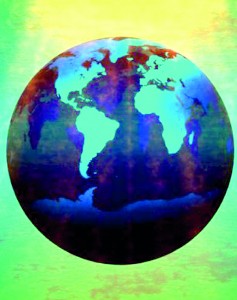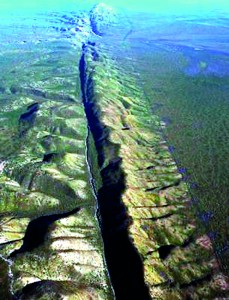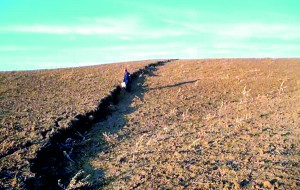Sunday Times 2
Has the plug been pulled out of the Atlantic?
Scientists have discovered a crack in the Earth’s crust that threatens to pull North America and Europe closer together and cause the

If the Eurasian plate cracks, the oceanic section will dive beneath the continental section causing the Atlantic Ocean to shrink and pull North America and Iberia closer together
Atlantic Ocean to vanish in about 220 million years.
Researchers at the University of Lisbon have created a new map of the seafloor, off the coast of Iberia-the region of Europe that includes Portugal and Spain- and the results show the beginnings of a new subduction zone.
National Geographic reported on the new data surrounding the subduction zones, and what could happen when the tectonic plates-the large rock slabs that make up the Earth’s crust-crash into one another.
The edge of the heavier plate slides, or subducts, below the lighter plate.
It then melts back into the Earth’s mantle-the layer just below the crust.
The discovery of this new subduction zone, published on June 6 in the journal Geology, could signal the start of an extended cycle that fuses continents together into a single landmass-or ‘supercontinent’-and closes our oceans.
This breakup and reformation of supercontinents has happened at least three times during Earth’s approximately four-billion-year history.
Speaking with National Geographic, the study’s first author João Duarte said that Earth’s continents could ‘look very much like the Pangea,’ in the far future, referring to a supercontinent that existed about 200 million years ago.
The newly discovered subduction zone is located in the Atlantic Ocean about 120 miles off the southwest coast of Portugal.
It’s composed of six different segments that span a total distance of about 186 miles.
The subduction zone is actually a new crack in the Eurasian plate – one of about a dozen tectonic plates that make up the Earth’s crust.
The Eurasian plate contains all of Europe and most of Asia.

Why do plates move? The sinking of cold lithosphere during subduction is thought to exercise some pull on a plate but not all plates experience subduction like that which is occurring at the San Andreas fault line
‘In this case, the Eurasia plate is breaking in two,’ Duarte said to National Geographic.
Scientists have long suspected that a new subduction zone was forming near the western margin of the Eurasian plate, off the coast of Portugal.
The region has long been the site of significant earthquake activity, including an 8.7-magnitude quake in 1755 that devastated Lisbon.
This kind of tectonic movement is also at work on the Pacific ‘ring of fire’, located at the borders of the Pacific plate and other major tectonic plates.
The Ring of Fire gets its name because it is composed of over 75 per cent of the world’s active and dormant volcanoes.
It is also the site of the Tohoku earthquke in 2011, and it was the undersea location of plate movement that caused of the devastating tsunami.
Over the past 20 years, several scientific teams from different countries have launched research cruises to map the seafloor around the region to look for proof that a new subduction zone was forming.
As part of his research project while at the University of Lisbon, Duarte gathered together the data from all of the different mapping projects and combined them to create a new tectonic map of the seafloor off the coast of Portugal.
The updated map provided the first conclusive proof that the ocean floor off the coast of Iberia is indeed beginning to fracture, and that a new subduction zone is starting to form.
‘It is not a fully developed subduction, but an embryonic one,’ Duarte said.

A fault line in Algeria shows where the African plate and the Eurasian plate collide and subduct
The evidence collected by Duarte’s team indicate that the Eurasia plate could eventually split into separate oceanic and continental sections.
If this happens, the oceanic section-which is made of denser rock-will dive beneath the continental section.
This will cause the Atlantic Ocean to shrink and pull North America and Iberia closer together.
Other studies have indicated that geologic activity in the region could also pull Africa and Iberia together, causing the Mediterranean Sea to vanish.
‘Eventually North America and Iberia will be together again, and the collision will give origin to new mountain chains like the Himalaya,’ Duarte said.
For now, scientists will continue to study the nascent subduction zone because it could help answer a long-lasting mystery: How do oceans-especially ones like the Atlantic that have ‘passive’ margins that are free of fractures-start to close? ‘For the first time we are seeing a [passive] Atlantic margin turn into a Pacific one,’ for which subduction zones are common, Duarte said in conversation with National Geographic.
His team plans to continue collecting data about the crust and seafloor in the region to further investigate the subduction zone. They are also developing computer and physical models of the subduction process and plate motions.
‘Understanding these processes will certainly provide new insights on how subduction zones may have initiated in the past and how oceans start to close,’ Duarte said.
© Daily Mail, London
Follow @timesonlinelk
comments powered by Disqus

